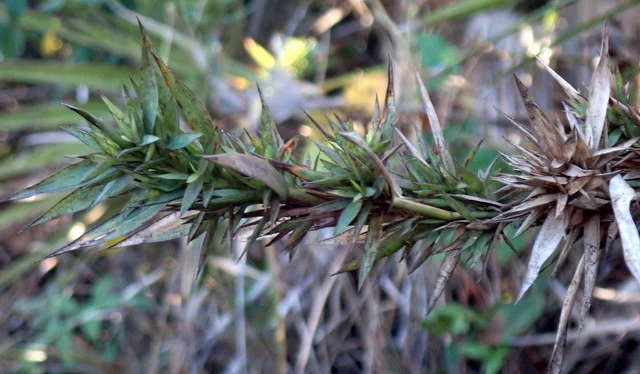Tall Swamp Panicgrass
(Dichanthelium scabriusculum)
Tall Swamp Panicgrass (Dichanthelium scabriusculum)
/
/

mfeaver
CC BY 4.0
Image By:
mfeaver
Recorded By:
Copyright:
CC BY 4.0
Copyright Notice:
Photo by: mfeaver | License Type: CC BY 4.0 | License URL: http://creativecommons.org/licenses/by/4.0/ | Rights Holder: mfeaver | Publisher: iNaturalist | Date Created: 2021-11-16T11:15:48-08:00 |

























Estimated Native Range
Climate Requirements for Cleburne, Texas
| This Plant | Your Site | Plant Suitability for Your Location | ||
|---|---|---|---|---|
| • Precipitation | 34" - 67" | 34" | Your precipitation may be insufficient for this plant. Irrigate N" / year. | Irrigate N" / year |
| • High Temp. | 76°F - 95°F | 97°F | Your summers may be too hot for this plant. | Too hot |
| • Low Temp. | -4°F - 54°F | 33°F | Your winter temperatures are normal for this plant | Excellent |
This plant should grow well at your location with about N inches per year (Y minutes per month) of irrigation.
Summary
Dichanthelium scabriusculum, commonly known as Tall Swamp Panicgrass, is a perennial grass native to wet meadows, marsh edges, and open swampy woodlands primarily in the eastern United States. It is a clump-forming grass that typically grows to a height of 1 to 3 feet (0.3 to 0.9 meters). The plant features narrow, lance-shaped leaves and produces small, greenish flowers in loose, open panicles during late spring to midsummer. The flowers are not particularly showy, but they do provide ecological benefits to the native habitat by supporting pollinators.
Tall Swamp Panicgrass is valued for its ability to thrive in wet conditions, making it suitable for rain gardens, wet meadows, and restoration projects. It is often used to stabilize soil and prevent erosion in moist areas. This grass prefers full sun to part shade and requires consistently moist to wet soils. It is not drought-tolerant and may require additional watering during dry periods. While not commonly found in the horticultural trade, it can be a useful plant for naturalistic landscaping in appropriate conditions. Potential problems include susceptibility to rust and fungal diseases in overly wet or humid conditions.CC BY-SA 4.0
Tall Swamp Panicgrass is valued for its ability to thrive in wet conditions, making it suitable for rain gardens, wet meadows, and restoration projects. It is often used to stabilize soil and prevent erosion in moist areas. This grass prefers full sun to part shade and requires consistently moist to wet soils. It is not drought-tolerant and may require additional watering during dry periods. While not commonly found in the horticultural trade, it can be a useful plant for naturalistic landscaping in appropriate conditions. Potential problems include susceptibility to rust and fungal diseases in overly wet or humid conditions.CC BY-SA 4.0
Plant Description
- Plant Type: Grass
- Height: 0.5-2 feet
- Width: 0.5-1 feet
- Growth Rate: Rapid
- Flower Color: N/A
- Flowering Season: Spring, Summer, Fall
- Leaf Retention: Deciduous
Growth Requirements
- Sun: Full Sun, Part Shade
- Water: Medium
- Drainage: Fast, Medium, Slow
Common Uses
Erosion Control, Low Maintenance
Natural Habitat
Native to wet meadows, marsh edges, and open swampy woodlands
Other Names
Common Names: Rough Panicgrass, Roughish Rosette Grass
Scientific Names: Dichanthelium scabriusculum, Panicum dichotomum var. elatum, Panicum eriophorum, Panicum eriophorum, Panicum lanuginosum, Panicum lanuginosum, Panicum nealleyi, Panicum scabriusculum, Panicum scabriusculum
GBIF Accepted Name: Dichanthelium scabriusculum